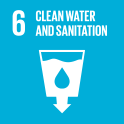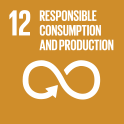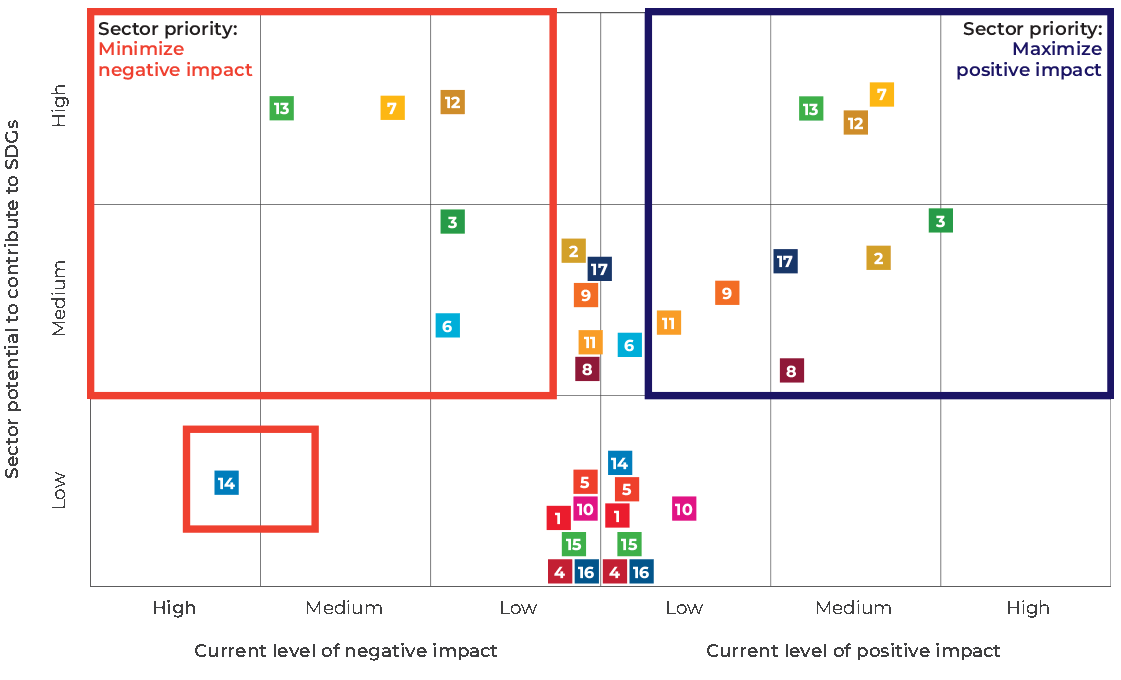The Chemical Sector
and the SDGs
Understanding the chemical sector and how it relates to the SDGs
Through the responsible production, use, and management of chemicals, the chemical sector can support the SDGs through innovative products and practices that minimize negative impacts, protect the environment, promote social progress, and support economic growth. Many of these principles are already enshrined in the industry’s Responsible Care® Program.
This Roadmap sets out to explore how the chemical sector can contribute to achieving the SDGs through more effectively managing its own operational footprint, working with others to enhance capacities along the value chain, and leveraging its expertise and innovation to unlock new business opportunities that are aligned with the SDGs. This will require action to minimize any adverse aspects while maximizing positive impacts.
The chemical sector at large is a supplier of products and services into virtually every other industry. Due to this, the Roadmap is not an exhaustive overview, but instead describes areas where the chemical sector is uniquely suited to make a considerable and lasting impact.
The Chemical Sector
- Commodity Chemicals. Companies that primarily produce industrial chemicals and basic chemicals. Including but not limited to plastics, synthetic fibers, films, commodity-based paints & pigments, explosives, and petrochemicals.
- Diversified Chemicals. Manufacturers of a diversified range of chemical products.
- Fertilizers & Agricultural Chemicals. Producers of fertilizers, pesticides, potash or other agriculture-related chemicals.
- Industrial Gases. Manufacturers of industrial gases.
- Specialty Chemicals. Companies that primarily produce high value-added chemicals used in the manufacture of a wide variety of products, including but not limited to fine chemicals, additives, advanced polymers, adhesives, sealants and specialty paints, pigments and coatings, and intermediates used in renewable materials and in the food, pharmaceutical, and other industries.
The complex and diversified nature of the sector is accounted for in the Roadmap, which is inclusive of all sub-sectors from basic chemicals, intermediates and formulated products through to end use markets.

RAW
MATERIALS
BASIC
CHEMICAL
- Olefins (ethylene propylene, butylene)
- Aromatics (benzene, toluene, xylenes)
- Chlor-Alkali (chlorine, caustic soda)
- Methanol
- Bio-based materials (e.g. sugars, starches, natural oils and acids)
- Others (eg., ammonia, phosphorous)
CHEMICAL
INTERMEDIARIES
- Commodities
- Differentiated commodities
- Technical specialities
FORMULATED PRODUCTS AND
PRODUCT MATERIALS
- Plastics and Engineering Resins
- Extruded films, pipes, profiles, coatings, sheets, foams
- Blow-molded parts
- Injection molded parts
- Composites
- Synthetic Fibers
- Rubber Products
- Paints & Coatings
- Adhesives & Sealants
- Lubricants
- Water Treatment Products
- Cleaning Products
- Industrial Chemicals
- Flame Retardants
- Many others…
CUSTOMERS OF
THE CHEMICAL INDUSTRY
- Automotive/ Transportation
- Consumer Products
- Packaging
- Building & Construction
- Recreation/sport
- Industrial
- Medical
- Pharmaceuticals
- Personal care
- Textiles
- Electrical/electronics
- Aircraft/aerospace
- Food
- Bio-based materials
Facts and figures
The global chemical industry is a $4 trillion enterprise that impacts virtually every sector of the economy. Over 95% of manufactured goods are touched by chemistry.
More than 20 million people around the globe are employed directly or indirectly by the chemical industry.
The energy savings enabled by chemical products are double those required to manufacture them.
In 2030 the solutions provided by the chemical industry could reduce emissions by 2.5 GtCO2e per year – a reduction equivalent to total emissions from France, Germany, Italy and the UK combined.
Highlights of innovative chemical sector sustainability initiatives
The sector’s approach to sustainability is long-standing. Here are selected examples that demonstrate how the sector is collaborating to tackle sustainability issues.
- Responsible Care® was first launched in 1985 and is a voluntary commitment by the global chemical industry to drive continuous improvement and achieve excellence in environmental, health and safety and security performance. Responsible Care encourages collaborative work between the domestic and international industry, government, and local authorities to help demonstrate best practices in safe chemicals management around the globe.
- The International Council of Chemical Associations (ICCA) launched the Global Product Strategy (GPS), in 2006, to advance the product stewardship performance of individual companies and the global chemical industry as a whole. Together with the Responsible Care Global Charter, GPS is the chemical industry’s contribution to the Strategic Approach to International Chemicals Management (SAICM). The overall objective of this policy framework, initiated by the United Nations Environment Programme (UNEP), is that by 2020, chemicals are produced and used in ways that minimize significant adverse impacts on human health and the environment. SAICM plans for sound management of chemicals and waste beyond 2020 are now in discussion.
-
The Together for Sustainability (TfS) initiative was set up in 2011 with the purpose of developing and implementing a global program to assess and improve sustainability practices within the supply chains of the chemical industry. More than 16 000 suppliers have been assessed (end of 2020); 75% of suppliers improved their audit scores upon evaluation and 57% of suppliers improved after re-assessment. The TfS program now also includes scope 3 GHG emissions. This program is to develop pragmatic approaches to measure GHG emissions data as well as to obtain it from TfS companies’ suppliers and share it across TfS member companies. It is paramount that the collected and shared data are consistent, reliable, robust and effective.
- The chemical sector, as a solutions provider, is an enabler of sustainability across value chains. In order to understand the opportunities and levers to reach scale, WBCSD chemical sector companies established a “Reaching Full Potential” initiative, which published three guidance documents: a framework to help companies assess the sustainability of their product portfolios; guidance to support chemical companies to assess the social impact of their products; and guidance for environmental footprint of products. Addressing the Avoided Emissions Challenge, guidelines for accounting for and reporting greenhouse gas (GHG) emissions avoided along the value chain based on comparative studies were also published in 2013 by the ICCA and WBCSD.
- The Chemicals in Products (CiP) Programme is an ongoing activity at UN Environment on the policy and practical facets of access to information on the chemicals contained in everyday products. The multi-stakeholder project developed a voluntary framework in 2015 to improve the exchange of information on chemicals contained in products and proposed cooperative actions to address gaps in the current levels of information access.
Highlights timeline


The Chemical Sector and the SDGs
The chemical sector is a partner, innovation enabler and solutions provider to essentially all sectors of the economy. The scale and diversity of the industry provide it with widespread opportunities to contribute to the realization of the SDGs by 2030.
The chemical sector can contribute to each of the 17 SDGs in different ways. Some of these are described below with accompanying case studies relating to existing partnerships that are helping to advance specific SDGs. The remainder of this Roadmap will seek to dive deeper and identify the SDGs where the sector has the most potential to drive transformation and innovation focused on lasting SDG impact.
Chemical sector interactions with the SDGs










manufacturers can advocate for equality in developed countries that the sector operates in, and provide investment into emerging and developing countries to encourage development that reduces inequality. Many companies have adopted global policies that support issues such as fair wages, safety and ethical standards, and social protections







- Develop multi-stakeholder and cross border partnerships and agreements to achieve sustainable development (e.g. Circular Economy, Water Stewardship, SAICM, etc.) with organisations such as WBCSD, WEF, ICCA, etc. Blueprints can be developed and leveraged;
- Collaborate with downstream partners, government organizations, NGO groups and other involved stakeholders working towards sustainable development;
- Contribute to improving environmental and safety performance in emerging countries through capacity building;
- Incorporate collaboration as a critical pillar of sustainability efforts/programs, and share technologies/science with partners to enhance sustainable development globally, and
- Encourage open innovation initiatives for the sector.
Key goals for the sector
Method and approach to prioritization
This is the first collective initiative by the chemical sector to extensively map and prioritize the 17 SDGs and their 169 targets in the context of the sector as a whole. This prioritization was conducted in order to narrow the wide playing field that the SDGs represent and identify the most critical focus areas for the sector in view of maximizing its capacity for SDG impact. This exercise was completed collaboratively with involvement from participating chemical sector companies and industry associations, WBCSD and external experts. The following four activities were undertaken:
- Exploration of how the chemical sector value chain interacts with each SDG;
- Identification of the sector’s current level of positive and negative impact on the goals;
- Assessment of the sector’s untapped potential to impact each goal and the potential for accompanying opportunities to create business value; and
- Mapping of SDGs in a materiality matrix to understand sector priorities.
Goals where the sector can have the greatest impact
10 goals were identified by the working group as being priority areas of engagement for the sector. These have been identified with the understanding that interdependencies exist across all the SDGs, and specific contributions related to one goal can have potentially positive or negative contributions to other goals. This is something that the sector should remain conscious of and alert to moving forward. Although SDG 17 (Partnerships for the goals) was not identified as a priority goal, it is recognized that the spirit of partnership and collaboration that it embodies is a recurring theme throughout this Roadmap and indeed is central to the exercise of undertaking a sector roadmap itself.
Prioritization of SDGs


Copyright © 2021
World Business Council
for Sustainable Development
All rights reserved
Privacy Policy
Follow us
Contact
MAISON DE LA PAIX
Chemin Eugène-Rigot, 2B
Case Postale 2075
CH-1211, Geneva 1
Switzerland
Tel: +41 (22) 839 3100
Fax: +41 (22) 839 3131

























